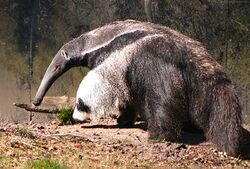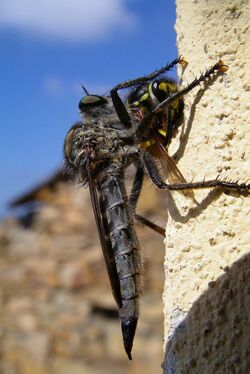Biology:Entomophagy

Entomophagy (/ˌɛntəˈmɒfədʒi/, from Greek ἔντομον éntomon, 'insect', and φαγεῖν phagein, 'to eat') is the practice of eating insects. An alternative term is insectivory.[1][2] Terms for organisms that practice entomophagy are entomophage and insectivore.
Entomophagy is sometimes defined to also include the eating of arthropods other than insects, such as arachnids and myriapods; eating arachnids may also be referred to as arachnophagy.
In non-humans

Entomophagy is widespread among many animals, including non-human primates.[3] Animals that feed primarily on insects are called insectivores.
In humans

Entomophagy is scientifically described as widespread among non-human primates and common among many human communities.[3] The scientific term describing the practice of eating insects by humans is anthropo-entomophagy.[4] The eggs, larvae, pupae, and adults of certain insects have been eaten by humans from prehistoric times to the present day.[5] Around 3,000 ethnic groups practice entomophagy.[6] Human insect-eating (anthropo-entomophagy) is common to cultures in most parts of the world, including Central and South America, Africa, Asia, Australia , and New Zealand. Eighty percent of the world's nations eat insects of 1,000 to 2,000 species.[7][8] FAO has registered some 1,900 edible insect species and estimates that there were, in 2005, some two billion insect consumers worldwide. FAO suggests eating insects as a possible solution to environmental degradation caused by livestock production.[9]
In some societies, primarily western nations, entomophagy is uncommon or taboo.[10][11][12][13][14][15] Today, insect eating is uncommon in North America and Europe, but insects remain a popular food elsewhere, and some companies are trying to introduce insects as food into Western diets.[16] A recent analysis of Google Trends data showed that people in Japan have become increasingly interested in entomophagy since 2013.[17]
See also
- Insects as feed
- Human interactions with insects
- Insects in medicine
- Insects as food
- Taboo food and drink
References
- ↑ Deluycker, Anneke (April 2017): Insectivory. In: The International Encyclopedia of Primatology. John Wiley & Sons . 10.1002/9781119179313.wbprim0062.
- ↑ Science Direct: Insectivory.
- ↑ 3.0 3.1 Raubenheimer, David; Rothman, Jessica M. (January 2013). "Nutritional ecology of entomophagy in humans and other primates". Annual Review of Entomology 58 (141–160): 141–160. doi:10.1146/annurev-ento-120710-100713. PMID 23039342.
- ↑ Ramos-Elorduy, Julieta (2009). "Anthropo-entomophagy: Cultures, evolution and sustainability". Entomological Research 39 (5): 271–288. doi:10.1111/j.1748-5967.2009.00238.x.
- ↑ "Entomophagy (Eating insects)". http://cisr.ucr.edu/entomophagy.html.
- ↑ Ramos-Elorduy, Julieta; Menzel, Peter (1998). Creepy crawly cuisine: the gourmet guide to edible insects. Inner Traditions / Bear & Company. p. 44. ISBN 978-0-89281-747-4. https://books.google.com/books?id=Q7f1LkFz11gC. Retrieved 23 April 2014.
- ↑ Carrington, Damian (1 August 2010). "Insects could be the key to meeting food needs of growing global population". The Guardian. https://www.theguardian.com/environment/2010/aug/01/insects-food-emissions.
- ↑ Ramos-Elorduy, Julieta (2009). "Anthropo-Entomophagy: Cultures, Evolution And Sustainability". Entomological Research 39 (5): 271–288. doi:10.1111/j.1748-5967.2009.00238.x.
- ↑ "Insects for food and feed" (Press releases). http://www.fao.org/edible-insects/en/.
- ↑ Meyer-Rochow, Victor Benno (2009). "Food taboos: their origins and purposes". Journal of Ethnobiology and Ethnomedicine 5 (18): 18. doi:10.1186/1746-4269-5-18. PMID 19563636.
- ↑ Weiss, M. L.; Mann, A.E. (1985). Human Biology and Behaviour: An Anthropological Perspective.. Little Brown & Co.. ISBN 978-0-673-39013-4.[page needed]
- ↑ McElroy, A.; Townsend, P. K. (1989). Medical Anthropology in Ecological Perspective. Westview Press. ISBN 978-0-8133-0742-8. https://archive.org/details/medicalanthropol00mcel.
- ↑ Saggers, S.; Gray, D. (1991). Aboriginal Health & Society: The Traditional and Contemporary Aboriginal Struggle for Better Health. Sydney: Allen & Unwin. ISBN 978-1-86373-057-0.[page needed]
- ↑ Gordon, David George (1998). The Eat-A-Bug Cookbook. Ten Speed Press. ISBN 978-0-89815-977-6.[page needed]
- ↑ Wilson, Charles B. (2015). All Cricket, No Bull.... CreateSpace. ISBN 978-1503079649.[page needed]
- ↑ Thompson, Addie (7 July 2013). "Want To Help Solve The Global Food Crisis? Eat More Crickets". Forbes. https://www.forbes.com/sites/ashoka/2013/07/31/want-to-help-solve-the-global-food-crisis-eat-more-crickets/.
- ↑ Takada, Kenta (31 March 2022). "Do Japanese interest in anthropo-entomophagy become really increased? – Analysis on the Japanese interest using Google Trend (preliminary study)". Bulletin of the Itami City Museum of Insects 10: 11–14. doi:10.34335/itakon.10.0_11. https://www.jstage.jst.go.jp/article/itakon/10/0/10_11/_pdf/-char/ja.
Further reading
- Domnas, Aristotle J.; Warner, Steven A. (1991). "Biochemical Activities of Entomophagous Fungi". Critical Reviews in Microbiology 18 (1): 1–13. doi:10.3109/10408419109113507. PMID 1854431.
- Ramos-Elorduy, Julieta (2009). "Anthropo-entomophagy: Cultures, evolution and sustainability". Entomological Research 39 (5): 271–288. doi:10.1111/j.1748-5967.2009.00238.x.
External links
- "Edible insects". New Scientist 193 (2595): 56. 2007. doi:10.1016/s0262-4079(07)60691-5. https://www.newscientist.com/channel/opinion/mg19325952.600-the-word-edible-insects.html.
- Edible insects: Future prospects for food and feed security
- Risk profile related to production and consumption of insects as food and feed European Food Safety Authority 2015
 |


